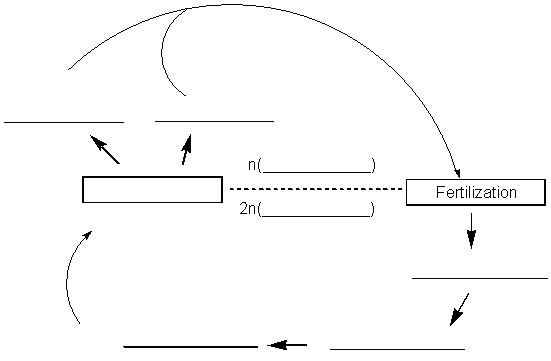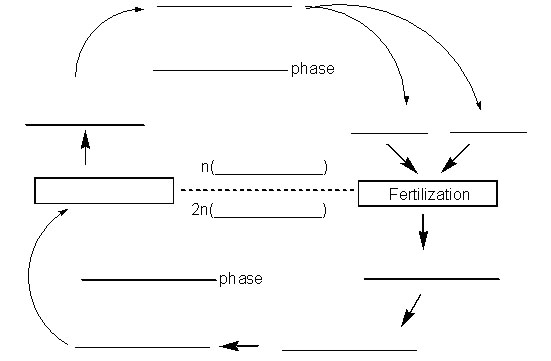
 |
Stephen G. Saupe - Biology Department, College of St. Benedict/St. John's University, Collegeville, MN 56321; (320) 363-2782; ssaupe@csbsju.edu |
Gink
and Go & the Botanical Birds and Bees
Setting: Gink is in the TV lounge watching “Baywatch” reruns.
Go is returning to his room from a night in the library studying plant
reproduction.
| Gink: | Hey Go, how was studying? | |
| Go: | Great. I learned all about sexual reproduction in plants. | |
| Gink: |
Give me a break – plants don’t have sex. But check out this show instead. |
|
| Go: | Get your mind out of the gutter. Don’t you remember how we defined sex in biology class? | |
| Gink: | Get real. | |
| Go: | Oh, right. Anyway, biologists define sex as the process of producing gametes by meiosis followed by their subsequent recombination during fertilization. The gametes that are produced are haploid – having only a single set of chromosomes. The zygote is diploid with two sets of chromosomes. This allows both mom and dad to contribute to the next generation. Watch, I’ll draw an outline of the typical sexual life cycle. Gink, why don’t you insert the following terms – zygote, embryo, adult, meiosis, haploid, diploid, sperm, egg - in the sexual life cycle diagram below? Circle the gametes. Syngamy is a synonym for which process? (Stop and complete the diagram/questions) |

| Gink: | Sure, but plants don’t have gametes. | |
| Go: | Of course they do – plants make both eggs and sperms. | |
| Gink: | No way. Where? | |
| Go: | That's a good question. Let's back-up a little first. | |
| Gink: | Oh no (moaning)! Does this mean I'm gonna miss more of my show? | |
| Go: | Well, maybe a little. Do you remember that Saupe said plants add a whole new wrinkle to the sexual life cycle? | |
| Gink: | He's the only wrinkled thing that I know about. | |
| Go: | I won't tell him you said that. He was talking about alternation of generations which is unique to plants. Plants alternate between a diploid sporophyte phase and a haploid gametophyte phase. | |
| Gink: | The sporophyte produces spores and the gametophyte makes gametes. | |
| Go: | Precisely! | |
| Gink: | And a flower is part of the gametophyte phase because it makes gametes. | |
| Go: | Nice try. It can be a little confusing. Let's draw out the generalized life cycle of a plant. Stop and complete the diagram below. Fill in the blanks with the following terms: sporophyte phase, adult sporophyte, gametophyte phase, mature gametophyte, sperm, egg, meiosis, zygote, embryo, haploid, diploid, and spore. Circle the gametes. |

| Gink: | Wow....this is even more complicated than the plot on Baywatch. According to this diagram, plants produce spores, not gametes, during meiosis. | |
| Go: | Right. And then the spore grows into a gametophyte plant which eventually produces the gametes - by mitosis. | |
| Gink: | Slow down - my head is starting to spin. What in the heck is a spore? | |
| Go: | They’re like seeds but they are much smaller and don’t have an embryonic plant inside. Spores are produced when a spore mother cell undergoes meiosis. | |
| Gink: | I didn't know that spores have a mother. Where does their mom live? | |
| Go: | Get serious. The male microspore mother cell is in the anther of the stamen and it divides meiotically to produce four microspores. Each microspore is haploid and develops into a male gametophyte. | |
| Gink: | And I'll bet that the female megaspore mother cell is in the ovule in the ovary. | |
| Go: | Right. And the megaspore mother cell divides by meiosis, also, but only one of the four megaspores survives to eventually develop into the female gametophyte. | |
| Gink: | I still don't understand how the gametophytes fit in. | |
| Go: | Well, let's start with the male. The microspore produced in the anther completes one mitotic division to produce a 2-nucleate pollen grain which is officially the male gametophyte. | |
| Gink: | That's it? That wimpy little thing is the entire male gametophyte? | |
| Go: | Yup. That’s one of the features of plant evolution – advanced plants like the angiosperms have smaller, more protected, gametophytes. | |
| Gink: | So what happens next? | |
| Go: | The pollen grain is is released from the anther and it is transferred to the stigma of a flower during pollination. | |
| Gink | So that's where the birds and the bees fit in! But I’m still confused….where are the sperm? | |
| Go: | Relax (say it as though you are exasperated), we're getting to it. When the pollen grain lands on the stigma it germinates and the pollen tube grows emerges from it. The tube grows through the style toward an ovule and along the way, one of the two nuclei - the generative nucleus - divides by mitosis to produce two sperm. | |
| Gink: | Only two sperm? Do they have tails and swim inside the pollen tube? | |
| Go: | Well, sort of. You're right that the flowering plants only produce two sperm but they are non-motile. They don't have any tail like mammalian sperm. They don't have to swim because the pollen tube kindly delivers them to the female. | |
| Gink: | How does the pollen tube know where to go? You know guys never ask for directions. | |
| Go: | Great question – the pollen tube probably follows a gradient of calcium or perhaps a plant hormone. | |
| Gink: | It's like the ovule is releasing perfume and the pollen tube is sniffing its way. | |
| Go: | You’ve been watching too much Baywatch, but essentially you’ve got it. | |
| Gink: | How about the eggs? | |
| Go | Remember the haploid megaspore that was produced during meisos? It divides by mitosis three times to produce an 8-nucleate stage. | |
| Gink: | Is one of the 8 nuclei in the female gametophyte the egg? | |
| Go: | Now you’ve got it. They eight nuclei rearrange to form the mature female gametophyte. Three of the nuclei migrate to the opening of the ovule and one of these serves as the egg. The other two are called synergids. | |
| Gink: | And then three other nuclei move to the opposite end of the gametophyte. These are called the antipodals, right? | |
| Go: | Wow, you amaze me sometimes. Don't forget about the other two nuclei, the polar or fusion nuclei. | |
| Gink | But what about fertilization? | |
| Go: | Cool your jets, we’re getting to that. The pollen tube grows into the ovule through the micropyle and releases the two sperm. One sperm fuses with the egg nucleus to make the zygote. The other fuses with the two polar nuclei to make a triploid cell that develops into the endosperm. | |
| Gink: | So plants have twice as much fun during sexual reproduction. | |
| Go: | That's right because there are two fertilization steps; one to make the embryo and the other to make a food source. Plants are the only organisms to have double fertilization. | |
| Gink: | Big deal…you’re making me hungry. Let’s call out for some pizza and finishing watching this show. | |
| Go: | OK. But first let's summarize what we've learned by modifying the generalized plant life cycle for the flowering plants. Complete the diagram below. (note there should be an arrow pointing to 'microspore mother cell' from the line beneath it) Fill in the blanks with the following: adult sporophyte, sporophyte phase, gametophyte phase, male gametophyte, female gametophyte, microspore, microspore mother cell, megaspore, megaspore mother cell, sperm, egg, meiosis, fertilization, zygote, embryo, haploid, diploid, stamen, anther, ovary, ovule, pistil, and flower. Circle the structure that is the pollen grain. Circle the structure(s) that make up the seed. Put a line on the diagram to represent where dormancy occurs. Circle the structure(s) that makes up a pollen grain. Where does pollination occur? |

Click here to download a pdf file of the diagrams: Diagram 1; Diagram 2; Diagram 3
|
| SGS Home | Disclaimer |
Last updated: April 19, 2007 � Copyright by SG Saupe